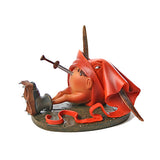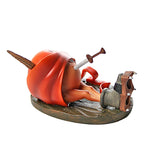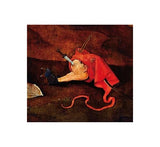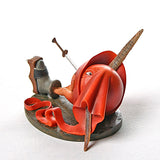Fat Belly Monster with Dagger Fantasy Figurine by Hieronymus Bosch Parastone 4L
PN# JB19On the right panel of the triptych, The Temptation of Saint Anthony, the devoted saint turns his head from the naked devil queen and her entourage. His gaze points at a set table, as a symbol for greed. The dagger in the creature's fat belly shows the consequences of intemperance. His eyes look out at you in acknowledgment. This statue replica of Bosch's two dimensional painting has extraordinary details from all side. You will look at it in wonder as to how Bosch's mind conceived of such an unusual little fellow.
- Material : Collectible quality, resin with hand-painted color details, matte and glossy finish.
- Statue replica is from the highly collectible Parastone Mouseion 3D Collection. PN JB19.
- Included : Full color card with image of original artwork. Description card about artist and artwork. Both cards are in four languages.
- Dimensions : 4 in L x 3.5 in W x 2.75 in H. Weight: 0.6 lbs.
ABOUT THE ARTWORK THE TEMPTATION OF SAINT ANTHONY: Saint Anthony won a lot of praise in Hieronymus Bosch's heyday. He resisted diabolical temptations, in sharp contrast with the ordinary mortals, as this triptych portrays in splendid colors. The closed panels show the arrest and crucifixion of Jesus.
ABOUT THE ART PERIOD: From an artistic point of view, the world famous brilliant forerunner of surrealism was, in his day, unique and radically different. Hieronymus (Jeroen for short) Bosch was born (ca. 1450-1516) during the transition from the Middle Ages to the Renaissance in 's-Hertogenbosch, in the Duchy of Brabant. Bosch places visionary images in a hostile world full of mysticism, with the conviction that the human being, due to its own stupidity and sinfulness has become prey to the devil himself. He holds a mirror to the world with his cerebral irony and magical symbolism, sparing no one. He aims his mocking arrows equally well at the hypocrisy of the clergy as the extravagance of the nobility and the immorality of the people. Hieronymus Bosch's style arises from the tradition of the book illuminations (manuscript illustrations from the Middle Ages). The caricature representation of evil tones down its terrifying implications, but also serves as a defiant warning with a theological basis.













